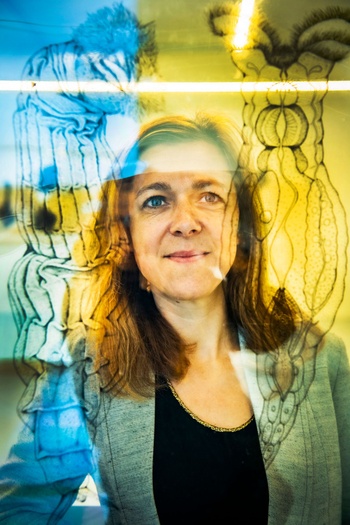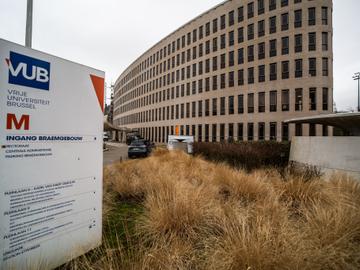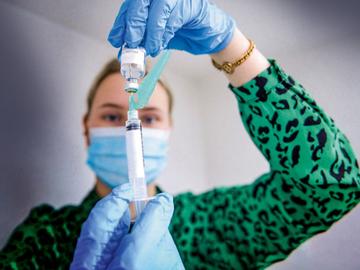Evolutionary biologist Karine Van Doninck is doing fundamental research into rotifers, small multicellular animals with a miraculous ability to adapt and which eventually might help us overcome cancers. In the exhibition “Manned Flight – Rotifers in Action” at Pilar, she and curator Ive Stevenheydens show that art and science, the two disciplines closest to her heart, share the same values.
© Saskia Vanderstichele
| Karine Van Doninck at Pilar: “Walking around here is magical. I always wonder why our labs and offices are so boring.”
Meet Karine Van Doninck
- Born in 1976 in Elsene/Ixelles, her father is the physicist Walter Van Doninck, former vice-president of the CERN Board
- 1994-2003: Licentiate and PhD in Biological Sciences at the VUB; she studies rotifers during her post-docs at Harvard University and in Montpellier
- 2007-2020: Full-time professor at the University of Namur where her research group focuses on bdelloid rotifers, all-female microorganisms that reproduce without male intervention and can survive in hostile environments thanks to their adaptability
- In 2015, she sets up the contemporary art B&B DRUUM with her partner Jo Huygh
- Receives a grant worth €2 million from the European Research Council for fundamental research on bdelloid rotifers (2017), starts inviting artists to her lab and sends rotifers to the International Space Station ISS in 2020 and 2021
- In 2020, she sets up the new research group Molecular Biology and Evolution at ULB
Sometimes, the young Karine Van Doninck spent weekends or evenings at the VUB/ULB laboratory for particle physics under the auspices of her father. “I remember the cellars where he and his team built modules for the CERN particle accelerator. I was intrigued by it even back then, but it was his unbridled passion as a freethinker that most inspired me.” The fact that she ended up choosing science, after a few detours, was no big surprise.
“My father always urged both my sister and me to do what we enjoyed doing. I am very grateful to him for that. My sister, who spent her days building models at home, now works at Jaspers-Eyers Architects as head of the model workshop. All the 3D prints in the exhibition are hers. I was intensely involved in tennis from the age of 10 (she once beat the six years younger Justine Henin, ed.), but at 16, I realised at international tournaments that I wasn’t going to make it in tennis, and I threw myself into science. I already knew that it would be biology, because I had lost a friend from tennis to cancer and wanted to understand what cancer was.”
Van Doninck quickly became fascinated by the way animals adapt to extreme environments and by the underlying mechanisms of our evolution: time and chance. “It is the accidental mutations that arise, together with cumulative, natural selection, that in the long run lead to wonderful adaptations and the diversity in which we now live,” she enthusiastically says in Pilar, the artistic lab of the VUB, where she put together the exhibition “Manned Flight – Rotifers in Action” alongside curator Ive Stevenheydens.
On the table in front of us is the card game “Evolution Game”. The cards are illustrated by Ophélie Lhuire and were designed to familiarise students with the theory of evolution in an accessible way. “I first used this idea of the card game in the Congo when I had to explain the concept of natural selection to people with a strong belief in God. It became my way of countering the rising tide of creationism, because as you play, you automatically start mixing cards and simulating mutations until you can beat your opponent by putting an advantageous mutation on the table. This way, I did not have to mention religion any more. The mechanisms of evolution are discussed and understood while playing, at least I hope so.”
Natural evolution
“People sometimes seem to find it easier to attribute our complexity to a god than to a process of natural evolution but of course it has long been scientifically proven that we are all built from the same basic genetic material and thus descended from the same ancestor. Bacteria, viruses, plants, animals, mushrooms and humans are made up of the same four basic molecules (the nucleotides in our DNA): A, C, G and T. Around 3.5 billion years ago, all our diversity emerged from that, with Homo sapiens as one of the recent branches of that evolution, having originated in Africa and migrated from there about 200,000 years ago.”
It is in fact Van Doninck’s dream that students would take the card game home to play it with their grandma or dad, also because she believes that the general public has the right to find out what knowledge fundamental research leads to – in this case: that cumulative advantage after many intermediate steps results in complexity and diversity. “The two million euro I received from the European Research Council for my research on rotifers ultimately comes from the tax payer, but they do not get to see enough of what we do with that money in our labs. Artists at least exhibit in a museum once in a while. Scientists only present their work in unreadable magazines.”
The urge to go public with her research became more urgent when, in 2016, Van Doninck received enough money from the European Space Agency to send rotifers to the ISS. “I wanted to show everyone why rotifers are a model organism for space research and started inviting artists to my lab. I already had a network through my artistic Bed & Breakfast DRUUM and from that, I then selected a few artists to interact with scientists investigating the extreme resistance and clonal reproduction of rotifers.”
'People sometimes seem to find it easier to attribute our complexity to a god than to a process of natural evolution but it has long been scientifically proven that we are all built from the same basic genetic material'
Passion and resistance
Why had she not thought of that before? For her talks, she has been using a few slides in which she lists characteristics of scientists: “Creativity, long-term and out-of-the-box thinking, failing every once in a while but going on until you make – Eureka! – discoveries, sometimes through serendipity, nevertheless daring constantly to question yourself and your research, being resilient and critical. I could have made the same slides about artists.”
She recently experienced the importance of coincidence and out-of-the-box thinking with one of her doctoral students. “He had gone home after a failed experiment and had forgotten to clean up, but the next morning he noticed something he had never seen before. We are now investigating this potentially important discovery further. Artists are also not afraid of something new emerging by chance, even if they often have a lot less money than scientists. In a way, the shrinking recourses for both basic research and culture bring us together. We can only succeed if we put passion and resistance into it. But I would still like to push for more recourses for basic research and art.”
The link between science and art runs like a thread through the exhibition, just like the overriding message and the passionate personality of Karine Van Doninck. “I trained tennis intensively when I was young and that taught me to be well organised and to give things up,” is how she describes why an academic career suited her so well. “My aim was not to make a rotifer exhibition, but to make people think around the deeper questions that such a fascinating micro-organism raises.”
Rotifers in space
Together with curator Ive Stevenheydens, the artists and works of art were meticulously selected and turned into a beautiful whole. There are no rotifers to be seen outside or on the ground floor of the exhibition, except in David Bade’s colourful and participative clay artwork. Van Doninck recognises an ecosystem that is constantly evolving. As they enter, visitors can watch the video Wonder Woman, on loan from the S.M.A.K. in Ghent. The American artist Dara Birnbaum made it in the 1970s as a parody of Superman. “But they don’t realise that on the top floor they will be confronted with the real superwomen who can reproduce without males.”

© Saskia Vanderstichele
| Karine Van Doninck: "Artists at least exhibit in a museum once in a while. Scientists only present their work in unreadable magazines.”
In his stop-motion film, Gerlando Infuso then evokes self-cloning, dancing and ultimately dying rotifers. “If we dehydrate them, we can keep them for hundreds of years, but if we bring them back to life, they will still simply die after their (average of thirty) days of life,” Van Doninck connects the reason why the micro-organisms are so interesting with a dry scientific truth.
Upstairs, the visitor is introduced to the Greek performance artist Natasha Papadopoulou, whom Ive Stevenheydens already knew and who during the pandemic sang that you should drink celery juice to boost your immune system, thus emphasising our internal ecosystem. “We often forget that we have more bacteria in our bodies than our own cells, and that we ourselves are a symbiosis that we constantly must keep in balance.” In a lab reconstructed by Ohme and Aiko Design, together with Karine Van Doninck, we finally see the real rotifers waking up and sticking together after they have had lettuce fluid. At the opening of the expo, attendees were also given drinks of lettuce fluids, said to be an even better and cheaper antioxidant boost than celery juice.
Looking at the photos by Caroline Vincart, who depicted the patience and meticulousness of her lab work, Van Doninck says that walking around here is magical. “I always wonder why our labs and offices are so boring. (Laughs) I have taught the odd practical course surrounded by the works of art and I love coming here to work. The beauty of the art gives me peace.”
During her research at the University of Namur, Van Doninck showed that rotifers undergo the same damage during dehydration as during exposure to ionising radiation and are therefore resistant to high doses of (proton) radiation. This is very unusual for living animals and also the reason why cancer research can benefit from it and why rotifers suddenly were considered suitable for space missions. “We have suggested that the European Space Agency use rotifers as a model organism: they can help to assess the impact of cosmic radiation on the genetic material and metabolism of astronauts.”
An inconvenient truth
That only strengthens the biologist’s case for studying and protecting nature even better. “The answers to many of our questions are there, we just need to find them. Like study animals that do not develop cancer. If you study organisms that survive freezing, then you may not need to store future vaccines at -80°C. Unfortunately, too often our system is dominated by short-term thinking and we do not invest enough in long-term studies where we do not know the outcome. That stands in the way of innovation. This exhibition wants to counterbalance that too.”
One of the apotheoses of the symbiosis between science and art that has occupied her for more than four years is the art project by the interdisciplinary collective SEADS (Space Ecologies Art and Design) which sent, along with the rotifers, a work of art to the International Space Station. On the square centimetre that was left next to the barcode on the ten plastic bags containing the rotifers, artist Angelo Vermeulen cloned his fingerprint in the shape of an X. The beginning of a journey that shows that also in art, variation leads to progress. Two 3D prints structurally represent the impact of the space mission on the rotifers but there is much more.
“Scientifically, we know that mixing different genetic material is better for our evolution,” Van Doninck concludes, revealing an inconvenient truth about cultural identity, which is what the SEADS artwork talks about. “The ‘I defend only my culture’ and ‘I am not open to others’ message, whether it comes from Hitler, Putin or anyone else, takes humanity down a dead end. We all left Africa as immigrants 200,000 years ago. Purely scientifically, we are all migrants.”
Read more about: Expo , Events & Festivals , karine van doninck , Ive Stevenheydens , pilar , VUB



